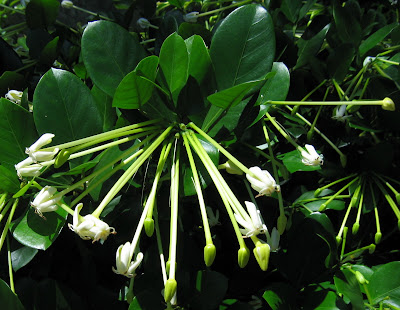Deep throat attracts moths*
Even this late in the year there are still some flowers coming into bloom in the ‘spring walk’. (Of course, there are plants in flower all through the year and we just get a peak in the spring months – whether you use the traditional or Entwisle system.)
A great example is the exotic looking, and sounding, Posoqueria, from Brazil and neighbouring countries in the north of South America. The name comes from the local Galibi people in French Guiana. They call the plant ‘Aymara-Posopheri’ – the aymara is a fish that eats fruits from this plant when the fall into water. These fruits are woody berries, a couple of centimetres in diameter, with a large seed in the middle of a jelly-like pulp.
Posoqueria longiflora, as this species is called, is sometimes called the Needle Flower Tree and you can see why. The white flowers are drawn out at the base into a narrow tube up to 35 cm long. They smell a little like gardenias, which are in the same family, the Rubiaceae.
The extremely long and narrow tube, and the white colour, of the flowers suggest this species is pollinated by hawkmoths, with their long ‘straws’ for sucking up nectar.
You may remember the story about the Madagascan Orchid in our Tropical Centre, Angraecum sesquipedale, and Darwin’s prediction that there would be a hawkmoth with a 30 cm long proboscis to reach down into that flower’s 30 cm long nectar spur. (That orchid flowers in September and its picture graces the top-right of this blog!)
In addition to encouraging the moth to stick its proboscis down the nectar tube, and position it so that pollen either falls onto or off its head, the Needle Flower Tree has another way to make sure the moth does the job properly.
The anthers (the male bits of the flower) are constrained within a sheath that peels back like a banana when the flower is ready to do its thing, but the anthers stay clinging together. When the anthers are primed, the flower may be closed or open.
If the flower is open, when the hawkmoth touches the clustered anthers there is a violent flick dusting the pollen onto the moth.
If closed, the hawkmoth will force its proboscis through the top of the flower bud, triggering the anther, and again getting a pollen dusting. It then takes this pollen to the next flower and we have cross fertilisation, so important for encouraging variation and of course the basis of Darwin’s theory of evolution.
Image: The long-throated blooms of the Needle Flower Tree in the Spring Walk at Sydney's Botanic Gardens.
*This Passion for Plants posting will also appear on the ABC Sydney website (under 'Weekends' or search 'gardening'), and is the gist of my 702AM radio interview with Simon Marnie on Saturday morning, between 9-10 am.

Comments